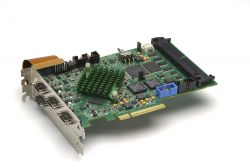Wave Gliders Collect Live Ocean Data from Hawaii's Kilauea Volcano Lava Flow
By using this unmanned technology, scientists have the rare opportunity to study the effects of the lava entering the ocean, the plume it creates and the interactions of the lava and seawater directly from the surface of the ocean.
SUNNYVALE, CA - June 25, 2018 - Liquid Robotics announces the deployment of two Wave Gliders, autonomous ocean robots, to capture live ocean data close to where lava is flowing into the ocean from Hawaiis Kilauea Volcano. By using this unmanned technology, scientists have the rare opportunity to study the effects of the lava entering the ocean, the plume it creates and the interactions of the lava and seawater directly from the surface of the ocean. Scientists note that very few volcanic eruptions and lava flows have ever been monitored in real time from the ocean.
Over the next three weeks, the Wave Gliders will operate a precise zig zag course, approximately 300m+ from the lava flow plume collecting rare subsurface, surface and atmospheric data. Working with top researchers from the University of Hawaii at Hilo, Massachusetts Institute of Technology (MIT), and the U.S. Geological Surveys Hawaiian Volcano Observatory (USGS-HVO), the Wave Gliders host a wide assortment of sophisticated sensors to measure: water temperatures, oxygen levels, pH levels, salinity, turbidity, conductivity and underwater acoustics. The Wave Gliders will stay on station, continuously capturing sustained, high resolution measurements and imagery throughout the mission.
"The effect of this massive lava flow entering the ocean is dramatic and amazing, but at the same time somewhat mysterious" said Roger Hine, CTO and co-founder of Liquid Robotics. "Detailed measurements of the ocean plume and the ecosystems it impacts are now possible and safe to obtain with unmanned systems like our Wave Gliders. This is an opportunity of a lifetime to deploy our ocean robots to help advance science."
By using an unmanned ocean robot vs. sending a research ship, researchers can collect scientific data on this rare volcanic event without risk to humans. This point was made upon arrival of the first Wave Glider at the lava flow location, surface water temperatures measured above 120F/49C. Conditions dangerous for humans, less so for ocean robots.
"The plume of hot, sediment-laden water generated by the lava flowing into the ocean spreads out, impacting surrounding ecosystems and permitted boaters operating in the area," said Dr. Steve Colbert, University of Hawaii at Hilo. "We dont know how far and how deep that plume extends, or how it changes with oceanographic conditions or changes in the flow of lava. The Wave Gliders provide us the opportunity to answer these important questions."
Data collected by the Wave Gliders will also help scientists observe in real time the impact of volcanic eruptions and lava flows on marine life (coral reefs and fish populations) and air quality affecting the Hawaiian islands. As a Company with roots on Hawaii island and a dedication to care for the environment and Hawaiis communities, understanding the quality of the lava haze (laze) generated by Kilauea is of great importance.
####
About Liquid Robotics, A Boeing Company:
Liquid Robotics designs and manufactures the Wave Glider, the first wave and solar powered unmanned ocean robot. With our partners, we address many of the planets greatest challenges, by transforming how to assess, monitor, and protect the ocean. We solve critical problems for defense, commercial, and science customers. Visit www.liquid-robotics.com to learn more.
Liquid Robotics and Wave Glider are registered trademarks of Liquid Robotics, Inc., a wholly owned subsidiary of The Boeing Company.
Featured Product

